How to Successfully Repot a Cannabis Plant
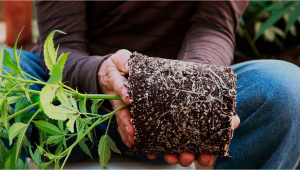
- 1. Why repot cannabis?
- 2. When to repot a cannabis seedling
- 2. a. Repotting root bound cannabis
- 2. b. Day or night?
- 3. Transplant your cannabis in a pot of the right size
- 4. How to repot cannabis in 4 easy steps
- 4. a. Step 1. water the bigger pot
- 4. b. Step 2. dig a hole
- 4. c. Step 3. slide the root ball out of the starter pot
- 4. d. Step 4. finish the transplant
- 5. If your weed did suffer from a transplant shock
- 6. Repotting weed during flowering: save it for emergencies only
- 7. Can i repot cannabis deeper?
There are dozens of situations when you have to transplant your cannabis into a bigger pot. While an auto grower may think about planting his autoflower straight into the final container, with photoperiod genetics, it’s best to use a starter pot and plan for a transplant into a bigger one before the flowering stage begins. To repot a cannabis plant successfully, you need to wait till it spans as wide as the container edges or has at least 4–5 nodes, choose a pot that is 2.5–5 times larger, and fill it with the same medium, not forgetting to water it. Then make a quick transplant without disturbing the roots.
It might seem like a lot of hassle to go to the effort of pulling your plant out of its smaller pot and placing it into a bigger one. However, doing so plays a very important role in proper plant development. A new pot allows cannabis seeds to expand their root systems. Larger pots are also filled with a fresh growing medium, which gives your plants access to much more nutrients going forward. You can look at repotting as somewhat of a coming-of-age or graduation ceremony. Your plant has successfully passed the test and completed this stage of its development. To continue to progress, the grower needs to move it to the next level! If you’re confused about the process of repotting, you don’t have to worry about a thing—we’ve got your back!
1. Why Repot Cannabis?
We’ll show you in more detail how to do it properly, but first, let’s talk about the right reasons to repot your marijuana. Research has shown that for many crops, including cannabis, transplanting actually helps achieve better yields. It’s because in smaller pots it’s easier to give your weed just the right amount of water. And if you use several tents for different grow stages and if your starter tent is small, the only way to go is to start your seedlings in smaller pots or even solo cups and later repot. Another good reason to use solo cups is to prepare seedlings indoors for an outdoor grow. And finally, an unplanned transplant may be necessary when your vegging plant has grown beyond your expectations.
Just don’t repot for wrong reasons. For example, because your autoflower grows too slowly or looks sick, or it’s overwatered. Transplanting is a potentially stressful procedure, so adding even more stress would hardly help. Also don’t try repotting flowering cannabis, hoping that this would make it grow bigger. Roots hardly grow during flowering, so repotting in flower doesn’t make much sense (see more of it below). Repotting cannabis also gives the grower a chance to improve the health of the root system. First of all, repotting at the appropriate time helps to prevent plants from becoming root bound (more on that in a moment). Structural issues aside, repotting serves as the perfect time to expose your plant to beneficial microbes that can help to prevent a host of issues. If you haven’t done so already, now is the time to harness mycorrhizal fungi.
Placing mycorrhizal spores or propagules into your new container will cause these microbes to colonize the roots. This might sound like some kind of disease process, but it isn’t! Instead, it catalyses a symbiotic relationship that’s mutually beneficial for your plant and the fungi within the soil. The fungi send out small white “hairs” called hyphae that penetrate the root system. Once inside, plant root cells envelop the hyphae and create a structure that's part plant and part fungi called mycorrhizae. This important structure serves as a site of resource exchange. The plant feeds the fungi some of the sugars that it creates during photosynthesis, along with amino acids and other important compounds.
In return, the fungi reach out into the soil and start to exude potent enzymes that are capable of breaking down organic matter into plant-available nutrients. Mycorrhizal fungi transport these nutrients into plants. But they do more than mine for elements crucial to plant health. They also store water and give some to cannabis plants, which will help to keep your crop alive and kicking in times of drought. On top of this, they also help to defend against root pathogens that have the potential to do serious damage to the roots and impact yields and plant health. Therefore, don’t just view repotting as a time to give your cannabis plants a new home. Look at it as an opportunity to improve plant health, vitality, and productivity through the use of beneficial microbes.
Is transplanting cannabis plants important?
In short, yes but it depends on a couple of things. Transplanting cannabis plants gives the plant’s roots more space to grow, allowing them to grow healthy and strong, preparing them for the flowering stage. If the plant outgrows the pot, the roots will become cramped and tangles, which is known as becoming rootbound and this will basically choke your plant, resulting in stunted growth, and sick appearance, and ultimately end up killing your plants. Remember, healthy roots equals healthy plants.
The pots will not only prevent roots from becoming rootbound but will also dictate how big your plants grow. This means that you don’t want to grow a cannabis plant in huge pots as you’ll probably end up wasting soil, water, and grow space but you also don’t want to grow them in tiny pots, so the idea is to know the desired plant size beforehand so you can use the right pot size. Most growers start in 500 ml up to 4 L pots when germinating and eventually transplant them to bigger pots, depending on the desired plant size. If you transplanted to a small pot, make sure to keep an eye out for these symptoms as they may appear similar to the symptoms of underwatering, which might confuse you.
- New plant growth appears weak
- Stunted bud development
- Reddening of the stems
- Nutrient sensitivity and deficiencies
2. When to Repot a Cannabis Seedling
Usually, you want to repot a seedling that has produced some 4–5 sets of true leaves. By this time, its roots have probably reached the sides and the bottom of the starter pot, and the root ball is strong enough not to disintegrate during the transplant.
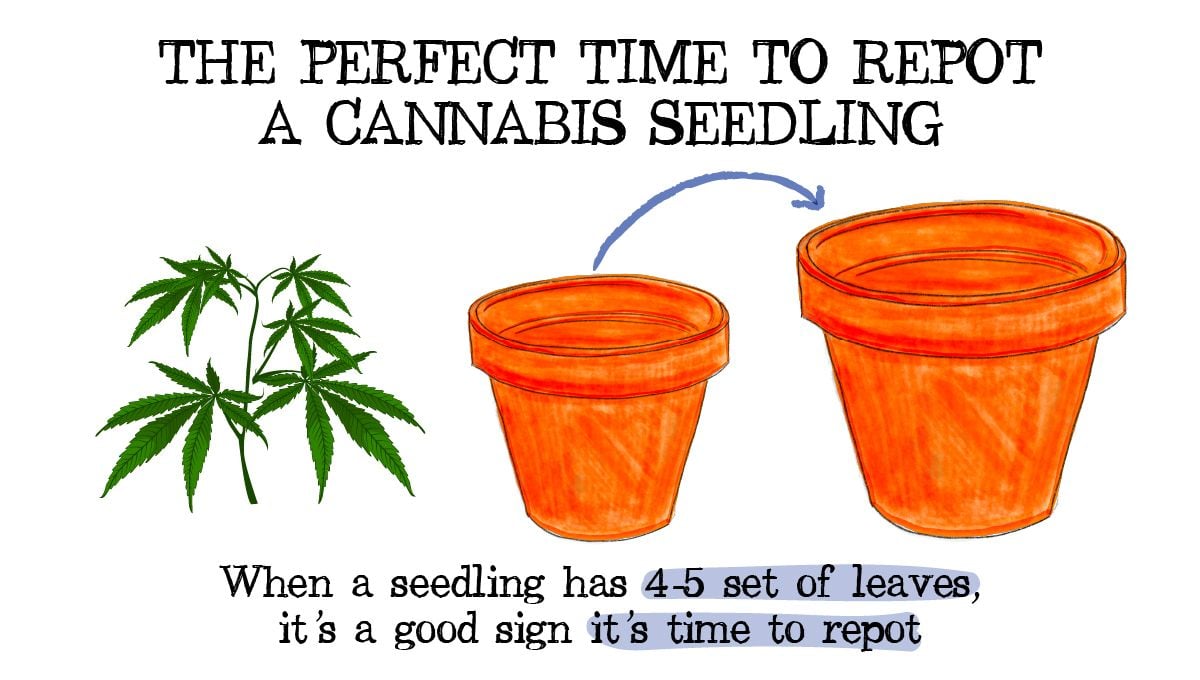
In solo cups, the right moment to re-pot may come sooner. In this case, use another rule of thumb: transplant when leaves have grown beyond the edges of the container. If the seedling/plant is bigger than the pot it sits in, the pot is probably getting too small for its root structure as well.
Repotting Root Bound Cannabis
If you have missed the perfect moment to transplant your weed plant, it may become root-bound. It’s a condition when the roots start to go in circles around the root ball because they have nowhere to go.
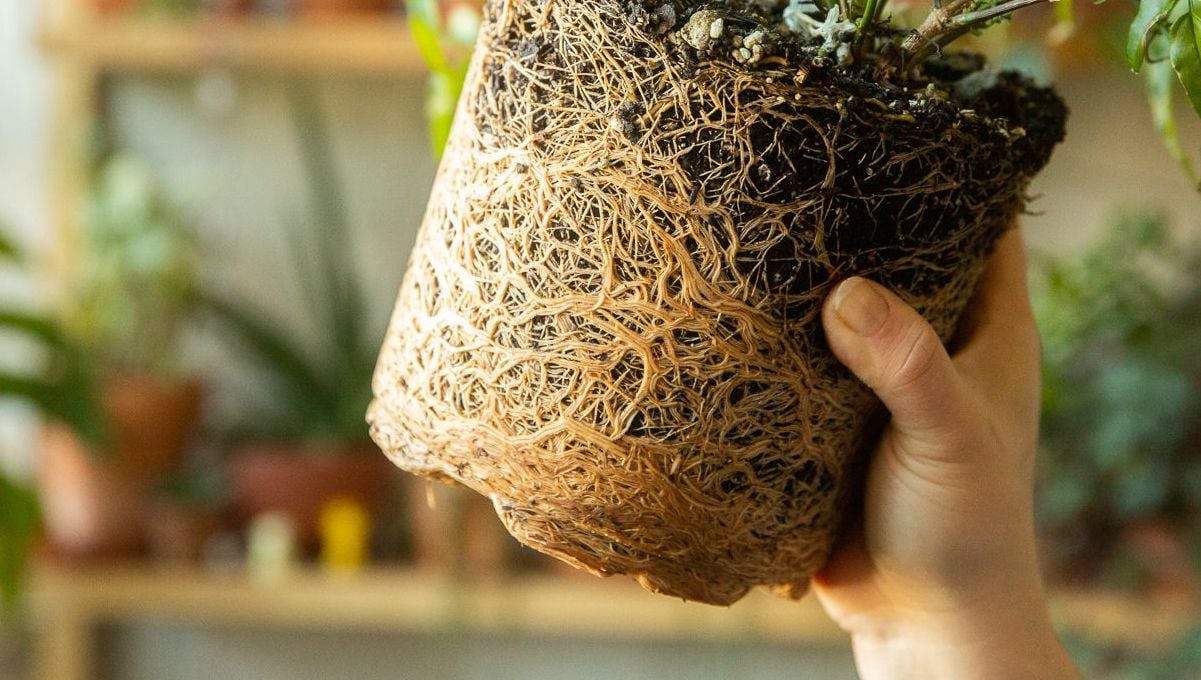
The general advice is to disturb the roots as little as possible, but not in the case of a pot-bound plant. Here you’ll need to gently disentangle individual roots from each other. And if it isn’t possible, cut some of them off, using a clean and sharp knife. Obviously, this will stress the plant and extend its recovery time after the transplant. However, this needs to be done.
Day or Night?
Some people also wonder if it’s best to repot during the day or night. We suggest doing it before lights-out indoors or in the late afternoon outdoors. The main reason is that roots do most of the growing at night. Besides, you don’t want to expose your transplanted marijuana to too much light/sun or high temps during the day. Having said that, when transferring your seedlings outdoors, look at the weather. If the nights are still cold and the days not hot yet, maybe it’s best to plant in the morning.
In all cases, make sure to avoid any sudden changes in growing conditions. The temperature, especially that of the medium, should remain the same as in the starter pot. But you can raise the humidity of your grow room a bit, especially if you have stressed your plant and its leaves begin to droop or wilt. And most importantly, the medium in your bigger pot should be the same as in the starter pot. If the roots, when they extend into the new medium, find it unfamiliar, this will add to the stress. As for the lighting conditions, watch your plants closely, and if you see symptoms of stress, think about raising the light for a day or two or dimming it. Outdoors, you may have to shade your young plants from the direct sun.
Main Indicators That You Should Transplant
Now, if you’re still not sure, here are the main indicators that your plant is ready to be transplanted:
Number of Leaves
In most cases, cannabis plants are ready to be transplanted after they’ve grown 4 to 5 pairs of true leaves, but keep in mind that this can vary from strain to strain.
Root Growth
Another way to know if it’s time to transplant is to check the drainage holes under the pot. Healthy plants should have a white room system that you’ll be able to see through the holes, if the roots are coming out of the holes then it’s time to transplant, especially if the roots have a dark hue as this is a sign of rootbound.
Flipping to 12/12
Cannabis plants go through the “flowering stretch” so it’s highly recommended to transplant to the final pot before your plant enters the flowering stage as your plant will increase in size and volume and the roots need a good amount of space to continue growing and sustain this new plant growth.
3. Transplant Your Cannabis in a Pot of the Right Size
Obviously, it doesn’t make much sense repotting your plant into a container that is barely bigger.
One important clarification: When we say ‘repotting’ in this article, we actually mean ‘potting up’, in other words moving our cannabis to a bigger pot. Strictly speaking, ‘repotting’ means pruning the roots that have become rootbound, adding new soil, and putting the plant back into the same container. This is something that cannabis growers do from time to time to their mother plants.
Experienced growers advise transplanting into a container 2.5–5 times as big as the previous one. Of course, if you begin your grow in solo cups, this rule doesn’t apply. You may want to transfer your seedling from a solo cup into a much bigger final container, such as a 5-gallon one in case of an autoflower.
4. How to Repot Cannabis in 4 Easy Steps
The procedure that we’re going to describe now guarantees the least amount of stress for your marijuana plants. There’s nothing difficult about it, but it requires some precision, speed, and dexterity. Unless you need to transplant a large cannabis plant, you can sure perform it alone.
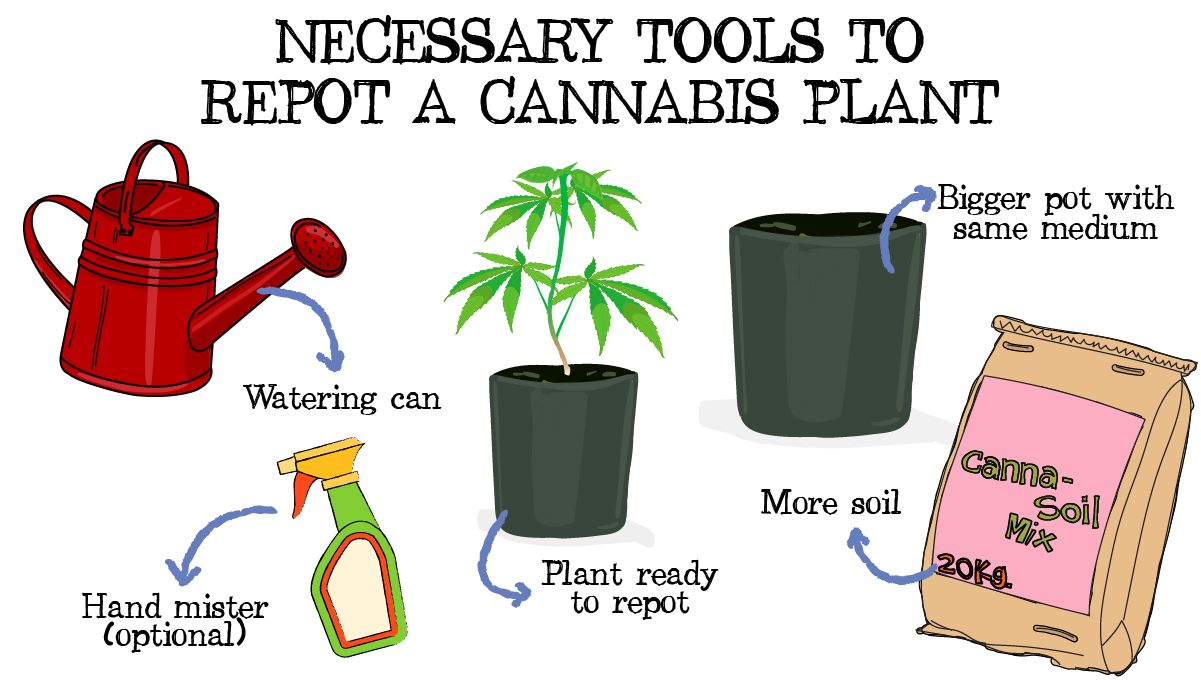
What You’ll Need
- a potted plant ready for a transplant,
- a bigger container filled with the exact same medium (soil),
- more soil for topping up,
- a watering can,
- some root booster (optional),
- a hand mister (optional).
Step 1. Water the Bigger Pot
You may want to do it a day before the transplant so that the medium settles. Moist medium is important to the roots to resume their healthy growth in their new home. It also makes performing the next step easier.
Step 2. Dig a Hole
Dig a hole in the bigger pot. Most probably, you’ll do it with your hands. Wear gloves if you want. The hole should be barely bigger than the starter pot, and you can use the latter for sizing. If the soil is moist, you’ll have no problem giving the hole the shape you want.
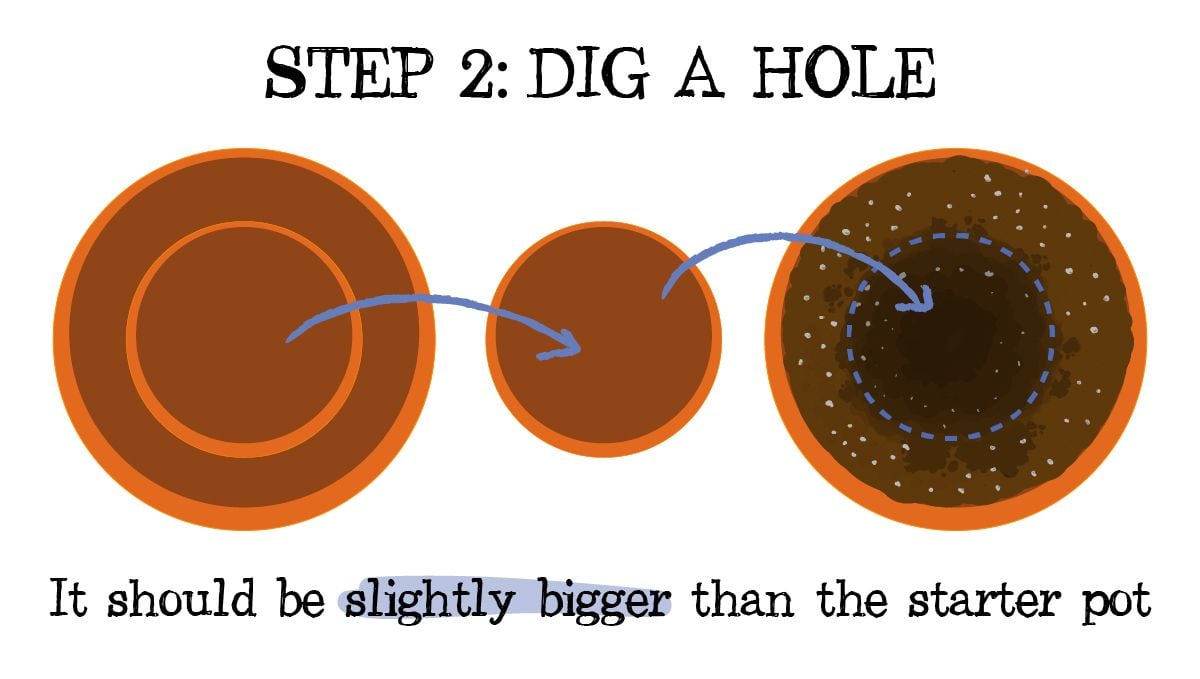
(Optional) If you decide to use a root booster solution to help the roots adapt to the new environment faster, spray some on the sides of the hole with a hand mister.
Step 3. Slide the Root Ball out of the Starter Pot
Your starter pot (or solo cup) has probably thin, flexible sides. So, massage them a bit to make the rootball separate from the walls. Then turn the container upside down, placing the surface of the soil on your hand and holding the plant’s stem between your fingers.
The container should slide off from the root ball easily. But if it doesn’t, massage its walls some more and make rotating motions to detach the medium from the sides.
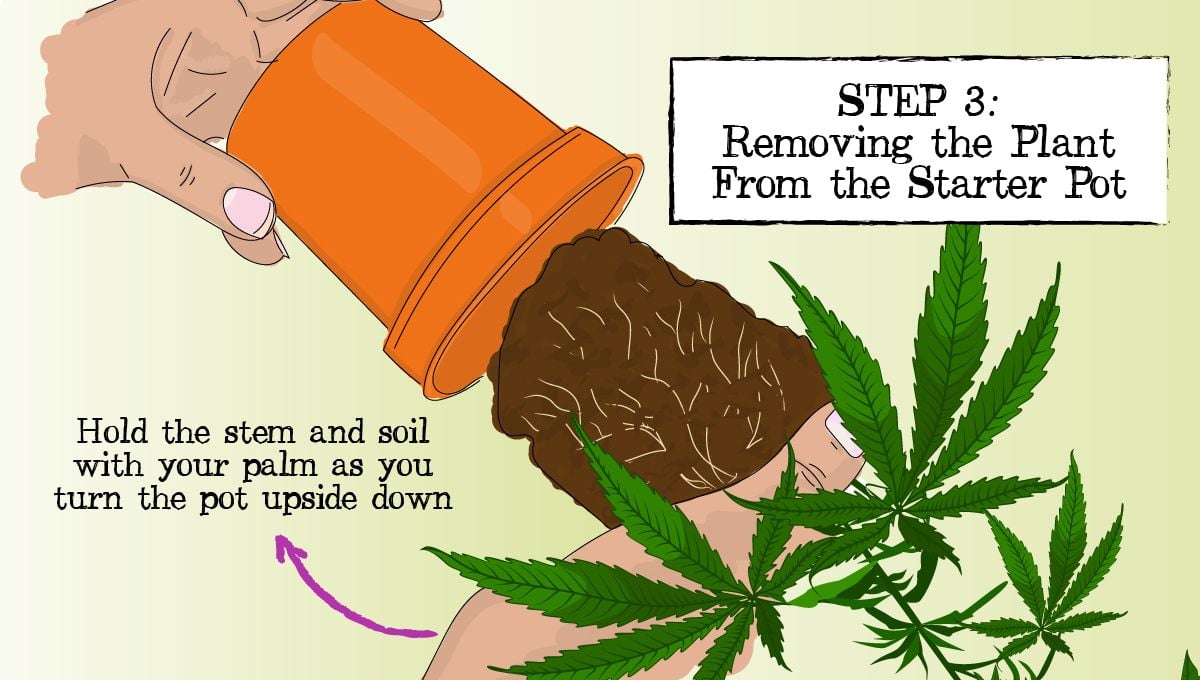
Wet or dry? It’s a very important question whether the soil in your smaller pot should be dry or wet. If it’s too dry, it may crumble and fall off during the repotting procedure. If it’s too wet, I can be very heavy and large chunks may fall off, tearing bits of the root system in the process. We recommend watering the day before the transplant because this will ensure the perfect moisture level.
Step 4. Finish the Transplant
Insert the root ball into the hole, add some soil around it and a thin layer on top of it. Then water some more to help the root ball settle. It’s a good idea not to pour water from the watering can, but to spray some with a hand mister. This way, you’ll give your roots the least disturbance.
5. If Your Weed Did Suffer from a Transplant Shock
The repotting procedure we described above has a great success rate, but sometimes, problems happen. If your plant has sustained root damage, you may notice some symptoms of stress or even shock. Your weed plant may show signs of slowed-down progress, look less vibrant and perky than before. Its leaves may droop or even start to wilt and turn yellow.
First, make sure to maintain the perfect conditions in terms of temps and humidity. You may want to lower the temperature a bit and raise the relative humidity of the air because when a plant is sick after repotting, it means that its roots aren’t working properly. They fail to draw as much water from the medium as the plant needs, so it makes sense to reduce the rate of perspiration. The same goes for the light which you may want to raise or dim. You may also want to use special transplant shock fertilizers (google them to find specific products for sale). These are basically root boosters that are also used for cuttings. They often contain very little nitrogen (N) because too much N is detrimental to the development of healthy roots. On the contrary, they often have the following nutrients and natural products:
| Phosphorus (P) | Positively affects root length and diameter. |
|---|---|
| Potassium (K) | A lack of it suppresses root development and plants’ overall ability to cope with stress. |
| Aloe vera | Enhances root growth and is widely used for cloning. |
| Kelp | Is full of growth hormones promoting root development. |
Growers often ask what the recovery time for repotting marijuana may be. It depends. Do everything right, and your plant won’t even notice the difference and will keep growing from day one. When there was some stress involved, you may notice slower growth and such symptoms as drooping and wilt for something like 3–4 days. After a week, a transplanted weed plant should recover.
6. Repotting Weed During Flowering: Save it for Emergencies Only
Not counting accidents and emergencies, you should always do repotting during the vegetative stage. The thing is that repotting means giving roots more room to grow, and this growth basically stops in flower. So make the last transplant BEFORE flower and never transplant flowering cannabis. Moreover, experts advise that you should do it a full two weeks before flowering. This gives your marijuana plant enough time to recover from the stress and its root structure to grow into a new medium. This is especially important for autoflowers with their very short veg. You either start them in their final containers or in solo cups. Then make the transplant in the second week from seed or so.
7. Can I Repot Cannabis Deeper?
Repotting cannabis deeper is a great idea if you transplant a young seedling. The thing is that its stem still has very delicate skin which easily grows new roots if you bury the stem in the medium. But when the plant gets older and the surface of its stem becomes hard and rough, avoid burying it during a transplant. You’ll only risk various fungi infections, leading to damping-off and stem rot.
External References
- Direct Seeding and Transplanting Influence Root Dynamics, Morpho-Physiology, Yield, and Head Quality of Globe Artichoke, Daniel I. Leskovar, Yahia A. Othman, Plants, 2021
- Effect of transplanting and direct sowing on productive properties and earliness of sweet corn, Teofil Gavric, Omer Omerbegovic, Chilean journal of agricultural research, Mar. 2021








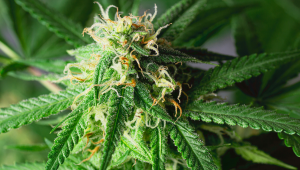
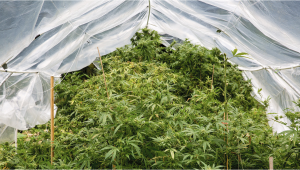



Comments